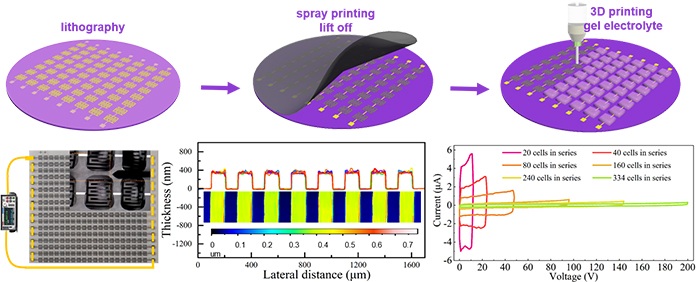Microscale electrochemical energy storage systems with high systemic performance, superior cell number density, tunable capacitance, and output voltage are promising for miniaturized electronics.
A joint research team led by Prof. WU Zhong-Shuai and Prof. LU Yao from the Dalian institute of chemical physics (DICP) of the Chinese Academy of Sciences (CAS), in collaboration with Prof. CHENG Huiming's group from Shenzhen Institute of Advanced Technology and the Institute of Metal Research of CAS, has developed monolithic integrated micro-supercapacitors with ultrahigh systemic volumetric performance and areal output voltages.
This study was published in National Science Review on Nov. 26.

The fabrication and electrochemical characterization of M-MIMSCs (Image by WANG Sen and LI Linmei)
On-chip interdigitated micro-supercapacitors (MSCs), free of separators and external metal connection wires and simultaneously with reliable electrochemical performance and tunable connection, can boost cell number density and systemic performance for monolithic integrated MSCs (MIMSCs) with desirable customizability in a limited space.
However, scalable production of fully-functioning compact MIMSCs with high systemic performance, superior cell number density and tunable performance is still challenging. This is due to the difficulty of precise deposition of electrolytes on densely-packed MSCs for electrochemical isolation, sacrifice in electrochemical performance during complex microfabrication procedures, and limited performance uniformity among numerous individual cells in large scale arrays.
In this study, the researchers developed a universal and large-throughput microfabrication strategy to address the above issues by combining multi-step lithographic patterning, spray printing of MXene microelectrodes, and controllable three-dimensional (3D) printing of gel electrolytes.
They fabricated the monolithic integration of electrochemically isolated micro-supercapacitors in closely proximity by leveraging high-resolution micropatterning techniques for microelectrode deposition and 3D printing for precise electrolyte deposition.
They obtained the MIMSCs with a high areal number density of 28 cells cm-2 (400 cells on 3.5×4.1 cm2), a record areal output voltage of 75.6 V cm-2, an acceptable systemic volumetric energy density of 9.8 mWh cm-3, and a high-capacitance retention of 92 % after 4,000 cycles at the output voltage of 162 V.
"This work paves the way for monolithic integrated and microscopic energy storage assemblies for powering future microelectronics," said Prof. WU.
This work was supported by the National Natural Science Foundation of China, the Strategic Priority Research Program of CAS, Dalian Innovation Support Plan for High Level Talents, and the China Postdoctoral Science Foundation. (Text by WANG Sen and LI Linmei)